Do you ever wonder what happens to your trash?
A year ago, my curiosity led me to sign up for one of the monthly tours of San Francisco Recycling & Disposal Solid Waste Transfer and Recycle Central.
Despite the threat of rain canceling the tour, me and my equally inquisitive partner, Sven, drove to the southern end of the city to take in the sights, sounds, smells, and surprises that awaited us.
Swarms of seagulls filled the air above the transfer facility property and provided a directional indicator that let us know we were almost there. They also added a bit of drama to the already ominous sky.
A verdant hillside spotted with creatures made from trash was a surprising feature of the landscape. Sighs of awe fell from our mouths when we learned that we were on our way to see the facility’s three-acre sculpture garden. Indeed! Here’s a place where plants rescued from the trash and creations made by participants in the center’s unique Artist-in-Residence (AIR) program live side-by-side.
AIR is the only program of its kind in the country and provides a four-month residency to local professional artists who create art from our trash. The artists have 24-hour access to the onsite studio and full access to our community’s garbage.
A springy piece of art spotted along the garden path. Concrete stepping stones decorated with computer circuit boards and the bottoms of glass bottles also caught my eye.
Inspiring in a different kind of way was “the pit”. Trash is dumped and collected here before being hauled to the landfill in Livermore, CA.
A few things we learned:
- There is no landfill in San Francisco.
- Trash is NOT sorted. If recyclable items are in the trash, they end up on in the landfill.
- Conversely, recycled items are sorted by hand (yes!) on conveyor belts at Recycle Central at Pier 96 – home of one of the largest state-of-the-art recycling facilities in the U.S. (Sadly, photography was not permitted at Recycle Central.)
- As the neighborhood’s largest employer, jobs at Recycle Central are coveted and are among the most well-paid for the predominantly low-income Bayview/Hunters Point residents.
Can you believe there are over 35 seagulls camouflaged in this snapshot of the trash pit? While there was little risk of trash falling on our heads, it was recommended that all tour participants don hardhats as protection from bird droppings. They seemed to work. No one was “hit” during our tour!
Unlike Sesame Street’s Oscar the Grouch, I do not love trash; however, this heaping flow of waste was mesmerizing. And in case you’re wondering, visiting this facility on a cool day minimized the olfactory impact!
Even furniture and spent mattresses await proper disposal.
Among the mandates of the California Integrated Waste Management Act of 1989 (AB 939) was a requirement that each city or county divert 50% of solid waste from landfill by 2000.
San Francisco is currently at 70% solid waste diversion from landfill with a goal of 75% by 2010.
Did you know there are four R’s? Reduce, reuse, recycle, rot.
The city’s three bin system and continued education of the public helps minimize San Francisco’s overall environmental impact.
On a daily basis, San Francisco generates between 1,600 – 1,800 tons of trash, 650 – 800 tons of blue bin recycling (excluding construction recycling), and 300 tons of food and yard trimmings (a.k.a. green bin compostables.)
Compost goes to the Norcal Waste Systems, Inc. facility called Jepson Prairie Organics in Vacaville, CA. This “unique recycling program diverts yard trimmings, food scraps and other compostable material from homes, restaurants, hotels, markets, delis, and coffee shops in the Bay Area.” Local farms sell produce grown with this compost at Bay Area farmer’s markets!
Plastics, glass, and aluminum are shipped overseas (mostly to Asia) for recycling. Due to the economy, the price for recyclable materials has dropped in recent months, and revenue at recycling facilities nationwide is down.
A little tip about shredded paper: it is not easily recycled. In order to give shredded paper the best chance at being recycled, it is advisable to collect it in PAPER bags and write “SHREDDED” in large letters on the bag. (Plastic bags, at least in San Francisco, and probably many other communities, are a no-no for this purpose!)
On Earth Day 2008, San Francisco began recycling non-electronic hard plastic toys. In other words, Mr. Potato Head can go in the blue bin! I still think it would be wonderful if we only made Mr. P.H. by using fully compostable ingredients, thus providing us with yet another reason to play with our food.
A post-tour endnote…
I walked away from the 2 1/2 hour tour inspired and motivated to infuse my new knowledge and insight more deeply into my own life and to share it with friends, family, clients, and readers like you.
So, what was my first conscious act to divert trash from landfill? Eating lunch at a local taqueria with Sven.
At the end of the meal, we sat there staring at the waxed paper cup from the beverage we shared, two piles of crumpled aluminum foil, dirty paper napkins, and some burrito remnants. We talked about what to do with them. If we put them in the restaurant’s trash can as we normally do, this little pile would end up in the landfill. If we gathered them up and brought them home in the paper cup, we could recycle and compost everything. We did the latter. I felt kinda deviant walking out of there with our bundle of trash. But you know what? It also felt really good.



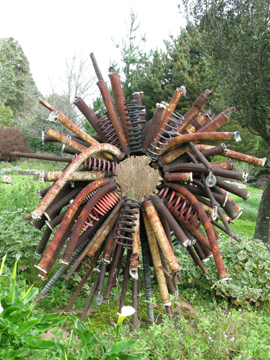


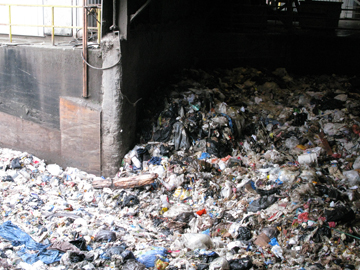
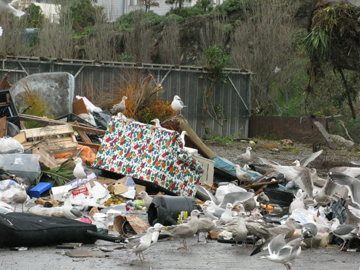



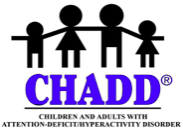
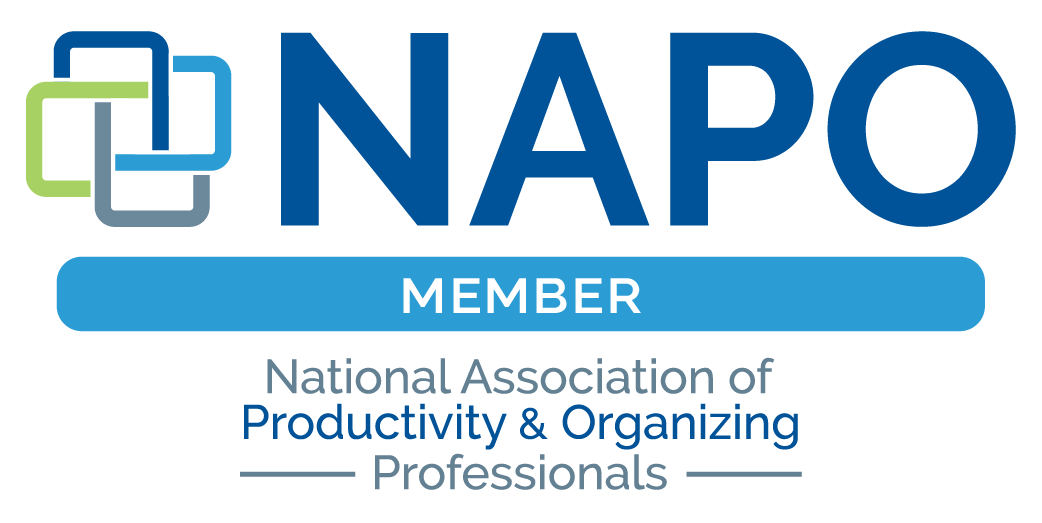

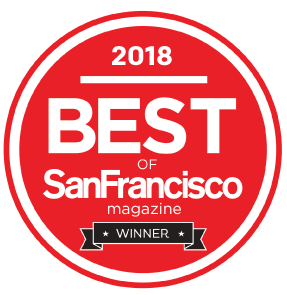
This is an absolutely fascinating look at the city’s trash! I’ve always wondered about how these things work in a city with such a small geographic footprint.
Upon seeing your picture, I realized I’ve driven right by the Transfer Unit (the seagulls should’ve been a dead giveaway). I had no idea you could tour it!
Could you tell me how you found out about the tour? I’d love to see it firsthand as opposed out the window of a car.
blog.greenpress.com
Ooh! I am so glad you visited the dump. I think everyone should try and go to their local dump/transfer station at least once, if only to understand the limits to recycling. When you see what the workers have to deal with separating our mixed materials, you realize why certain areas only accept certain types of plastics and that taking the plastic bits out of your electronic device and placing them in the recycling bin (which I’ve heard about people doing) is just a roundabout way to the landfill.
I’ve toured 3 sites now — SF, Oakland, and San Leandro — and all three are pretty much the same. And all three ship most of our recycling to China.
BTW, another thing people can do with their shredded paper is put it in the green compost bin. AND they should not put thermal receipts in with their shredding whether they recycle or compost. Thermal receipts have Bisphenol-A in them, and as a result, we are finding BPA in recycled toilet paper!
I got to tour Jepson Prairie and took (illegal) pictures which I’ve never posted on my blog because we were forbidden to and I didn’t want to get the woman who organized the tour in trouble.
I love that you packed out your trash. Awesome!
Beth – We weren’t allowed to photograph at Recycle Central at Pier 96. That place was filled with such a tremendous roar of things being sorted. It was powerful. Jepson Prairie has been on the list of places to visit, and it’s disappointing to learn they prohibit photography.
By the way, thank you for the reason why we should not “recycle” thermal receipts. No one – until now! – has provided me with a reason why. Time to spread the word!
I wish more people knew about this tour. I truly believe if every citizen got to see the amount of garbage we produce and where it goes, people would at least think before buying stuff and tossing it. It’s why I have mixed feelings about the old “stash your trash” campaigns, it encourages us to get garbage out of our minds. The tour is amazing, and I’d pick the trash art garden over a museum visit any day.
Pingback: Liberate Your Space! « A World of Words
Pingback: What comes out the other end… « A World of Words